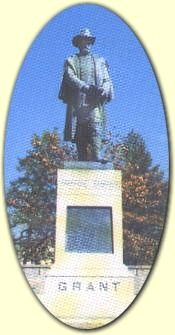Leavenworth County, KS
 The land where Leavenworth and Fort Leavenworth are located today was originally inhabited by the Kansa, Osage and Delaware Indians and today many of our streets are named after these and other local Indian tribes.
The land where Leavenworth and Fort Leavenworth are located today was originally inhabited by the Kansa, Osage and Delaware Indians and today many of our streets are named after these and other local Indian tribes. Somewhere in the vicinity of present day Salt Creek Valley northeast of Leavenworth, the French operated a fur trading post for possibly a score of years in the mid-1700's. This was the earliest white settlement of the region.
In 1827, Colonel Henry Leavenworth founded Fort Leavenworth on the bluffs of the Missouri River. For the next several decades Fort Leavenworth played an important role in keeping the peace among the various Indian tribes and the increasing number of settlers heading west. By the 1840's, travel to Oregon and California had begun and thousands of wagons passed through Fort Leavenworth on the way to the Santa Fe and Oregon Trail.
In 1854, the City of Leavenworth was founded as the very first city of Kansas.
In 1858, the Sisters of Charity of Leavenworth settled here. In 1864, the Sisters opened St. John's Hospital and in 1923 founded St. Mary College.
In 1863, the legislature passed an act to erect the Kansas St. Penitentiary on a site which is now located within the city of Lansing. The contract to build the prison was let in 1863 and work started in 1864. However, because of money difficulties connected with the Civil War, work stopped in 1864 and did not resume again until 1866. The building was first occupied in 1868.
In 1878, Lansing was platted into town lots.
In 1881, the school that was later to become the U.S. Army Command and General Staff College was founded on Fort Leavenworth by General William T. Sherman. Some of the many famous students and instructors at the college are George C. Marshall, Dwight D. Eisenhower, Douglas MacArthur, Colin Polwell and George Patton.
In 1885, the Wadsworth of Old Soldiers Home was built, and later became the Veterans Administration Center. In 1893, the Immanuel Chapel, made famous in Ripley's "Believe It or Not", was built on the V.A. grounds.
In 1906, the first cellhouse of the Leavenworth Federal Penitentiary was opened. Among the infamous criminals incarcerated here were Al Capone, Machine Gun Kelly and Robert Staud, the Birdman of Alcatraz.
There are a great deal of wonderful sites and experiences waiting for you and we hope that you will get the opportunity to enjoy some of our renowned Kansas hospitality.
Explore Leavenworth County
Command & General Staff College
The School of Application for Cavalry and Infantry, established in 1881.
Fort Leavenworth, KS CollegesThe Fairchild/Knox Historic Barns
The Fairchild/Knox hay barn and milk parlor are now the Community building and the museum of the Tonganoxie Historical Socitey. The original barn was built in 1901, but burned down in 1928. Frank Fairchild, with his wife, Mattie, formerly of Ulster County, NY started the dairy with 40
Tonganoxie, KS Historic BarnsOld Stone Wall
The Stone wall behind and across the street from Grant's statue is a favorite with photographers. The wall was restored in the early part of this century by the Daughters of the American Revolution.
Fort Leavenworth, KS LandmarksLansing Historical Museum
A little bit of the past has been saved by a group of Lansing History enthusiasts, who dreamed of preserving the Old Atchison, Topeka and Santa Fe Train Depot, now sitting on a tree-shaded grounds in central Lansing.
Lansing, KS MuseumsCarroll Mansion
A visit to this museum is an experience into the past. You will enter a Victorian home finished in 1882. It features elaborate handcrafted woodwork throughout the house, beautiful stained glass windows and elegant antiques from the Victorian age era to the early 20th century.
Leavenworth, KS MuseumsLeavenworth Historical Wayside Tour
Leavenworth, the "First City of Kansas", invites you to take a walk back in time and explore the history of "Where the West Began" by visiting our Historic Wayside Tour.
Leavenworth, KS ToursThe Rookery
The Rookery at 12-14 Sumner Place is the oldest house in Kansas. It was completed in 1834 and was the first permanent post headquarters building. Lieutenant Douglas MacArthur lived here in the early 1900s. The building is a Registered National Landmark.
Fort Leavenworth, KS Famous HomesRiverfront Convention & Community Center
One of Leavenworth's "jewels" is the totally renovated and expanded 1888 Union Pacific Train Depot, now called the Riverfront Convention & Community Center. It is listed on the National Register of Historic Places. Located at 123
Leavenworth, KS Community CentersNational Fred Harvey Museum
The National Fred Harvey Museum seeks to: * Restore the Harvey residence in Leavenworth to its historic magnificence. * Increase public awareness of Mr. Harvey's achievements and his contributions to civilizing the great American Southwest. *
Leavenworth, KS MuseumsFrontier Army Museum
The Frontier Army Museum depicts the Frontier Army (1817-1917) and history of Fort Leavenworth (1827-present). The original collection began in 1939 when the wagon shop at Fort Leavenworth closed and the horse-drawn vehicles were relocated and called the "Old Rolling Wheels Museum". In 1960
Fort Leavenworth, KS MuseumsFrench Cannons
These beautiful artifacts of bygone wars remain a mystery at Fort Leavenworth. They were cast in the 1700s in Paris; the name of the foundryman and place and date of manufacture are on each piece. How or why they came to Leavenworth is unknown.
Fort Leavenworth, KS Military HistoryU.S. Disciplinary Barracks
The "DB," as it is known, was established as a military prison in 1873. The buildings inside date from 1863 to 1964. The DB is the only military maximum security facility. This USDB closed in 2003 and the inmates were moved to the new USDB on the west side of the fort. The 'castle'
Fort Leavenworth, KS Historic Buildings